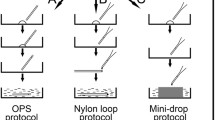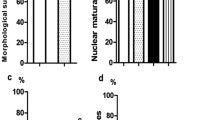Abstract
Purpose
To establish a freeze-thawing method for unfertilized oocytes with a high success rate, we examined several conditions for freeze-thawing. The effects of EDTA and cocultures in oviducts on the development of embryos fertilized in vitro after thawing were also studied.
Results
In the first experiment, unfertilized oocytes that were frozen in 1.5 Mdimethylsulfoxide (DMSO) supplemented with 0.2 Msucrose by a slow freeze-thawing method showed the best results (fertilization rate, 71.9%; blastocyst rate per frozen oocyte, 18.8%). The proportion of embryos that developed to blastocysts was significantly higher when DMSO was added at 4‡C than at room temperature (39.4 vs 19.4%; P<0.01). The addition of EDTA (10 ΜM)to the culture medium did not promote embryo development after fertilization in vitro. However, the rate of development of in vitro fertilized embryos to blastocysts after thawing was significantly higher when the embryos were cultured in oviducts in vitro than the rates in control cultures and those cultured with EDTA (blastocyst rate from fertilized oocytes, 71.4 vs 51.0 and 52.8%, respectively; P<0.01).
Conclusion
Unfertilized mouse oocytes can be cryopreserved successfully by a slow freeze-thawing method with the addition of 1.5 MDMSO and 0.2 Msucrose at low temperatures, and coculture with oviducts enhances the development of embryos that are fertilized in vitro after thawing.
Similar content being viewed by others
References
Shaw PW, Fuller BJ, Bernard A, Shaw RW: Vitrification of mouse oocytes: Improved rates of survival, fertilization, and development to blastocysts. Mol Reprod Dev 1991;29:379–384
Quinn P, Kerin JFP: Experience with the cryopreservation of human embryos using the mouse as a model to establish successful techniques. J Vitro Fert Embryo Transfer 1986;3:40–45
Al-Hasani, Diedrich K, van der Ven H, Reinecke A, Hartje M, Krebs D: Cryopreservation of human oocytes. Hum Reprod 1987;2:695–700
Quinn P, Barros C, Whittingham DG: Preservation of hamster oocytes to assay the fertilizing capacity of human spermatozoa. J Reprod Fert 1982;66:161–168
Cohen J, Kort HI, DeVane GW, Massey JB, Eisner CW, Turner TG Jr, Fehilly CB: Cryopreservation of zygotes and early cleaved human embryos. Fertil Steril 1988,49:283–289
Joly C, Bchini O, Boulekbache H, Testart J, Maro B: Effects of 1,2-propanediol on the cytoskeletal organization of the mouse oocyte. Hum Reprod 1992;7:374–378
Imoedemhe DG, Sigue AB: Survival of human oocytes cryopreserved with or without the cumulus in 1,2-propanediol. J Assist Reprod Genet 1992;9:323–327
Johnson MH, Pickering SJ: The effect of dimethylsufoxide on the microtubular system of the mouse oocytes. Development 1987;100:313–324
Trounson A, Kirby C: Problems in the cryopreservation of unfertilized eggs by slow cooling in dimethyl sulfoxide. Fertil Steril 1989;52:778–786
Goddard MJ, Pratt HP: Control of events during early cleavage of the mouse embryos: An analysis of the 2-cell block. J Embryol Exp Morphol 1983;73:111–133
Muggleton-Harris A, Whittingham DG, Wilson L: Cytoplasmic control of preimplantation development in vitro in the mouse. Nature 1982;299:460–462
Abramczuk J, Solter D, Koprowski H: The beneficial effect of EDTA on development of mouse one-cell embryos in chemically defined medium. Dev Biol 1977;61:378–383
Hoshi M, Toyoda Y: Effect of EDTA on the preimplantation development of mouse embryos fertilized in vitro. Jpn J Zootech Sci 1985;56:931–937
Biggers JD, Gwatkin RBL, Brinster RL: Development of mouse embryos in organ cultures of fallopian tubes on a chemically defined medium. Nature 1962;194:747–749
Surrey ES, Quinn PJ: Successful ultrarapid freezing of unfertilized oocytes. J Assist Reprod Genet 1990;7:262–266
Bongso A, Ng SC, Sathananthan H, Ng PL, Rauff M, Ratnam S: Improved quality of human embryos cocultured with human ampullary cells. Hum Reprod 1989;4:706–713
Menezo Y, Hazout A, Dumont M, Herbaut N, Nicollet B: Coculture of embryos on Vero cells and transfer of blastocysts in humans. Hum Reprod 1992;7 (Suppl 1):101–106
Wiemer KE, Hoffman DI, Maxson WS, Eager S, Muhlberger B, Fiore I, Cuervo M: Embryonic morphology and rate of implantation of human embryos following coculture on bovine oviductal epithelial cells. Hum Reprod 1993;8:97–101
Author information
Authors and Affiliations
Rights and permissions
About this article
Cite this article
Murayama, S., Yamano, S., Kobayashi, T. et al. Successful freezing of unfertilized mouse oocytes and effect of cocultures in oviducts on development of in vitro fertilized embryos after thawing. J Assist Reprod Genet 11, 156–161 (1994). https://doi.org/10.1007/BF02332093
Received:
Accepted:
Issue Date:
DOI: https://doi.org/10.1007/BF02332093




